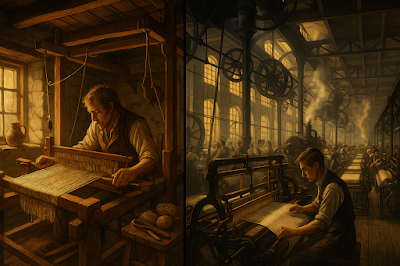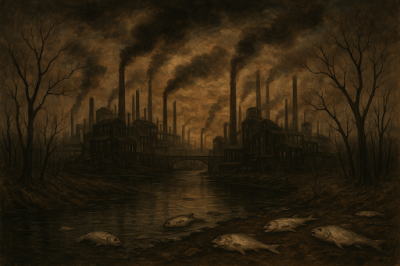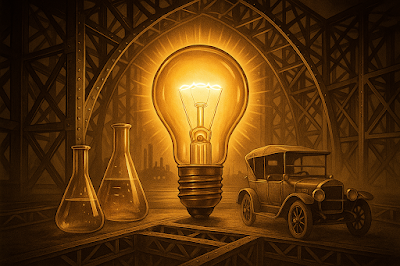⚙️ The Industrial Revolution: Causes, Inventions, and Lasting Impact on Modern Society 🏭
The Industrial Revolution was a monumental shift from handmade goods to machine-powered production, transforming society, economy, and technology. Beginning in 18th-century Britain, it introduced factories, urbanization, and innovations like the steam engine and railroads. While it spurred progress, it also brought challenges like child labor and pollution. This revolution laid the foundation for the modern world, shaping everything from global trade to today’s digital age.
🌍 Introduction to the Industrial Revolution
❓ What Was the Industrial Revolution?
Imagine a
world where everything was made by hand — clothes, tools, even buildings. Then
suddenly, machines came along and transformed everything. That’s what the
Industrial Revolution did.
The
Industrial Revolution was a massive shift in the way goods were produced. It
started in the late 1700s and lasted through the 1800s. Before it, most people
lived in small villages and worked in agriculture. Afterward, cities grew
rapidly, factories popped up, and the modern world began to take shape.
💡 Why Was It So Important?
This
wasn’t just about machines — it was about how people lived, worked, and even
thought. It changed:
- How goods were made (from hand to machine)
- Where people lived (from farms to cities)
- How fast ideas and products
spread
(thanks to trains and steamships)
It laid
the foundation for everything we use today — from smartphones to skyscrapers.
🌾 Before the Revolution – Life in the Pre-Industrial World
🌱 Agriculture-Based Society
In the
early 1700s, most people worked on farms. Life was slow-paced. People grew
their own food and made their own clothes. Everything depended on the seasons
and the land.
🧶 Cottage Industries and Manual Labor
Many
families worked from home, spinning wool or weaving fabric in small workshops.
This was known as the "cottage industry." It was slow and limited —
people could only produce small quantities at a time.
🚜 Transportation and Trade Challenges
Travel was
difficult. Roads were muddy and unreliable. It took days or even weeks to move
goods across the country. This slowed down trade and made it hard to grow
businesses.
🔥 The Spark of Change – Causes of the Industrial Revolution
⚙️ Technological Advancements
New
inventions began popping up. Machines that could spin thread faster, engines
that ran on steam, and tools that made farming more efficient. These
breakthroughs made large-scale production possible.
⛏️ Natural Resources and Geography
Britain
had what it needed to power industry: coal, iron, and rivers for
transport. These resources gave it a big advantage over other countries.
🏛️ Political and Economic Stability in Britain
Britain
had a stable government and strong banking system. This meant inventors could
get loans to start businesses, and people felt safe investing in new ideas.
👨👩👧👦 Population Growth and Urbanization
A boom in
population meant more workers and more customers. People began leaving the
countryside for cities, where factories needed labor.
🇬🇧 Where It All Began – The Birthplace of Industry
Why Britain Led the Way
Britain
had:
- Natural resources (coal and
iron)
- A strong navy to protect trade
- A network of colonies for raw
materials and markets
- A curious culture that
encouraged invention
It was the
perfect storm for industrial change.
Spread to Europe and Beyond
Soon, the
rest of Europe, the United States, and even parts of Asia caught on. Ideas and
machines moved quickly, thanks to improved transportation and communication.
💡 Game-Changing Inventions and Innovations
🚂 The Steam Engine
Invented
by James Watt, the steam engine was the beating heart of the revolution.
It powered factories, trains, and ships, making everything faster and more
efficient.
🧵 The Spinning Jenny and Textile Machines
Inventions
like the Spinning Jenny and the water frame made cloth production
faster and cheaper. This transformed the textile industry, one of the first to
industrialize.
👕 The Power Loom
With the
power loom, factories could produce fabric in bulk. It replaced hand weavers
and turned textiles into a massive global business.
⚙️⚫ Iron and Coal – Building the Backbone of Industry
Iron was
used to build machines and railways. Coal-powered engines. These two materials
were essential to the success of the Industrial Revolution.
🚂 Transportation Revolution
🚢 Canals and Roads
Canals
were like highways for boats. They made it easy to move heavy goods like coal
and iron. Roads were also improved, allowing carriages and wagons to travel
faster.
🛤️ The Railway Boom
Railroads
connected cities and countryside. Trains moved people and products quickly and
cheaply. By the mid-1800s, trains were everywhere.
🚢 Steamships and Global Trade
Steamships
crossed oceans. This helped countries trade with each other more efficiently.
Products like cotton, tea, and sugar were moving across the world at lightning
speed.
🏭 Life in the Industrial Age
🏙️ Urbanization and Growing Cities
As
factories spread across the land, people moved to cities in search of jobs.
Villages transformed into bustling towns almost overnight. But rapid growth
came with problems — overcrowded neighborhoods, poor housing, and not enough
clean water or waste systems.
Cities
like Manchester and Birmingham became icons of this new
industrial world. But life there wasn’t always easy.
⚒️ Working Conditions in Factories
Factory
life was harsh. Workers toiled for 12–16 hours a day, six days a week.
Breaks were rare, wages were low, and safety was almost nonexistent. Machines
were dangerous, and injuries were common.
No health
insurance. No paid holidays. No job security. Just hard, repetitive work.
👶 Child Labor and Family Life
Children
as young as 6 years old were put to work. Why? Because they were small,
cheap, and could squeeze between machines.
Entire
families worked to survive. Childhood often meant work instead of school. Many
children grew up too fast, losing their health and hope along the way.
🤢 Public Health and Sanitation Issues
Cramped
housing, no clean water, and overflowing sewage meant disease spread quickly.
Cholera, typhoid, and tuberculosis were common. Life expectancy in industrial
cities was shockingly low — sometimes just 25 to 30 years.
💰 Social and Economic Impacts
🎩 Rise of the Middle Class
Not
everyone suffered. A new middle class — made up of factory owners,
managers, and skilled workers — began to emerge. They lived in better
neighborhoods, wore fine clothes, and had access to education and luxuries the
working poor could only dream of.
👩🏭 Changing Roles of Women and Children
Women
found jobs in textile mills and factories. While they gained some independence,
they were still paid far less than men. The idea of a woman working outside the
home was new and controversial.
Children’s
roles changed too — eventually, people began to question child labor and pushed
for reform.
📈 Growth of Capitalism and Free Markets
The
Industrial Revolution helped spread capitalism, an economic system based
on private ownership and competition. Entrepreneurs became rich, and economies
shifted from farming to manufacturing.
Markets
became global. Supply and demand ruled the game. The era of kings and
landowners was giving way to the age of merchants and machines.
🌍 Environmental Consequences
☁️ Pollution and Overcrowding
Factories
pumped out smoke, soot, and chemical waste. Rivers turned black with industrial
runoff. Cities were wrapped in clouds of coal dust. This was the beginning of
large-scale air and water pollution.
Living
conditions were filthy. Air quality was terrible. Nature paid a heavy price for
progress.
⚫ Resource Depletion
Coal mines
were dug deep. Forests were cut down. The demand for raw materials was endless.
The environment was being drained to feed the industrial beast — with no
thought of sustainability.
✊ Reforms and Resistance
👥 Labor Unions and Strikes
Eventually,
workers had enough. They began to organize into unions, demanding better
pay, safer conditions, and shorter hours. Strikes and protests swept across
cities.
Some
governments resisted. Others gave in slowly, making small improvements.
📜 Factory Acts and Government Intervention
Laws like
the Factory Act of 1833 started to limit child labor and working hours.
Over time, more laws followed, protecting workers’ rights and introducing
safety rules.
These
early reforms laid the foundation for the labor rights we have today.
🚩 Rise of Socialism and Marxist Thought
Not
everyone liked capitalism. Thinkers like Karl Marx argued it created
rich elites and poor masses. He and others promoted socialism — the idea
that factories and wealth should be owned by all, not just a few.
This clash
of ideas shaped politics for the next two centuries.
⚡ The Second Industrial Revolution
💡🏗️ Electricity, Steel, and Chemicals
By the late
1800s, a second wave of innovation hit. New inventions included:
- Electric power (replacing steam)
- Steel (stronger than iron)
- Chemicals (used in medicine, farming,
and manufacturing)
This
second revolution was faster, wider, and even more powerful than the first.
Expansion into the USA and Germany 🇺🇸🇩🇪
The U.S.
and Germany quickly became industrial giants. Cities like Chicago, Berlin,
and Detroit exploded with factories, trains, and new jobs.
This shift
set the stage for the modern world economy — and two world wars.
🏁 Lasting Legacy of the Industrial Revolution
📱 Modern Technology Roots
Everything
from your smartphone to the internet can trace its roots to the Industrial
Revolution. It taught us how to build, invent, and scale up, turning small
ideas into global game-changers.
🧬👨🏫Changes in Education and Science
As
machines replaced manual labor, education became more important. Schools
expanded. Science and engineering were celebrated. A new era of curiosity and
invention was born.
🌐 Today's Global Economy
Global trade, international companies, and digital technology — all of it began with factories, coal, and steam. The revolution never really ended. It just evolved.
🎯 Conclusion: The Revolution That Changed the World
The
Industrial Revolution wasn’t just a shift in machines — it was a shift in
humanity. It changed where we live, how we work, and even what we dream about.
Yes, it brought hardship and struggle. But it also sparked creativity,
innovation, and a future of infinite possibilities.
From dark
factories to glowing cities, from steam engines to supercomputers — this
revolution shaped the world we know today.
❓ FAQs
1. What
were the top inventions of the Industrial Revolution?
The steam
engine, spinning jenny, power loom, and telegraph were game-changers that
transformed industries and societies.
2. Why
did it start in Britain?
Britain
had natural resources, political stability, a strong economy, and colonies that
provided materials and markets — the perfect mix for industrial growth.
3. How
did it impact daily life?
It moved
people to cities, created new jobs, introduced machines, but also brought poor
living conditions and long working hours.
4. What
were the major drawbacks?
Pollution,
child labor, overcrowded cities, and dangerous working conditions were serious
problems during the revolution.
5. How
does it affect us today?
The
technologies, urban lifestyles, and global trade we rely on today are all
rooted in the Industrial Revolution’s innovations.



.png)











